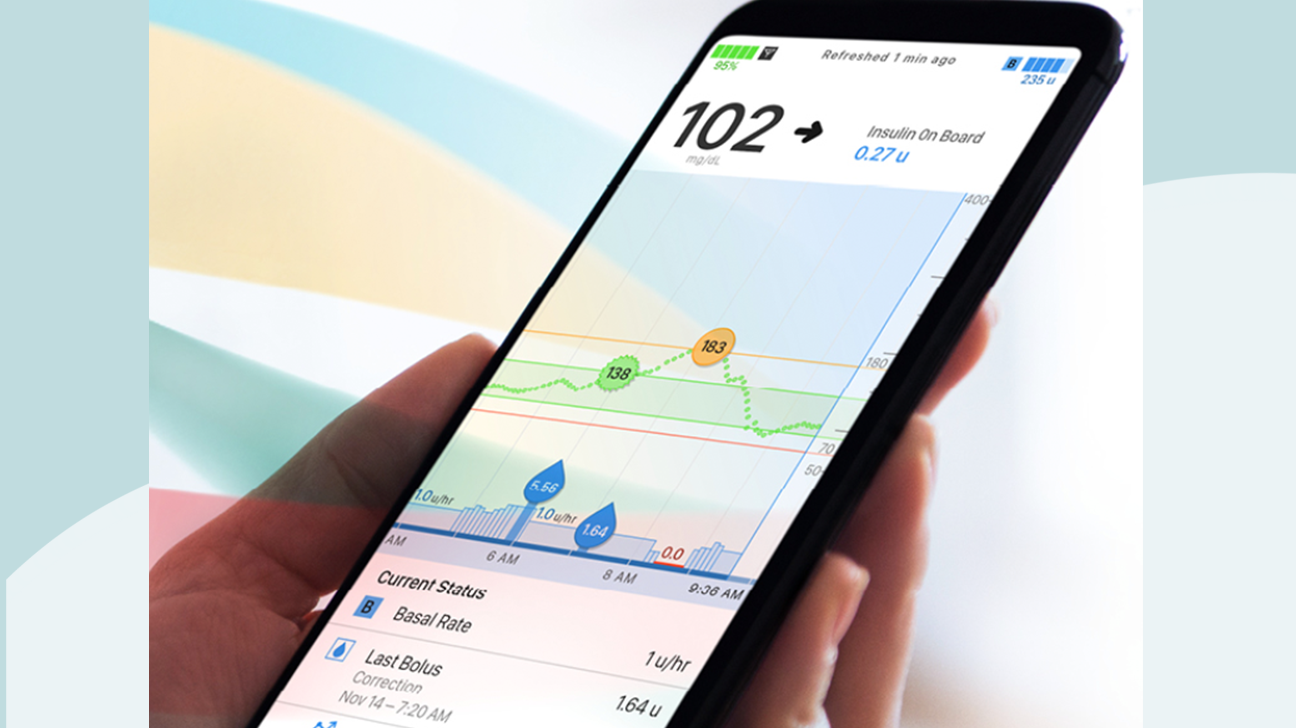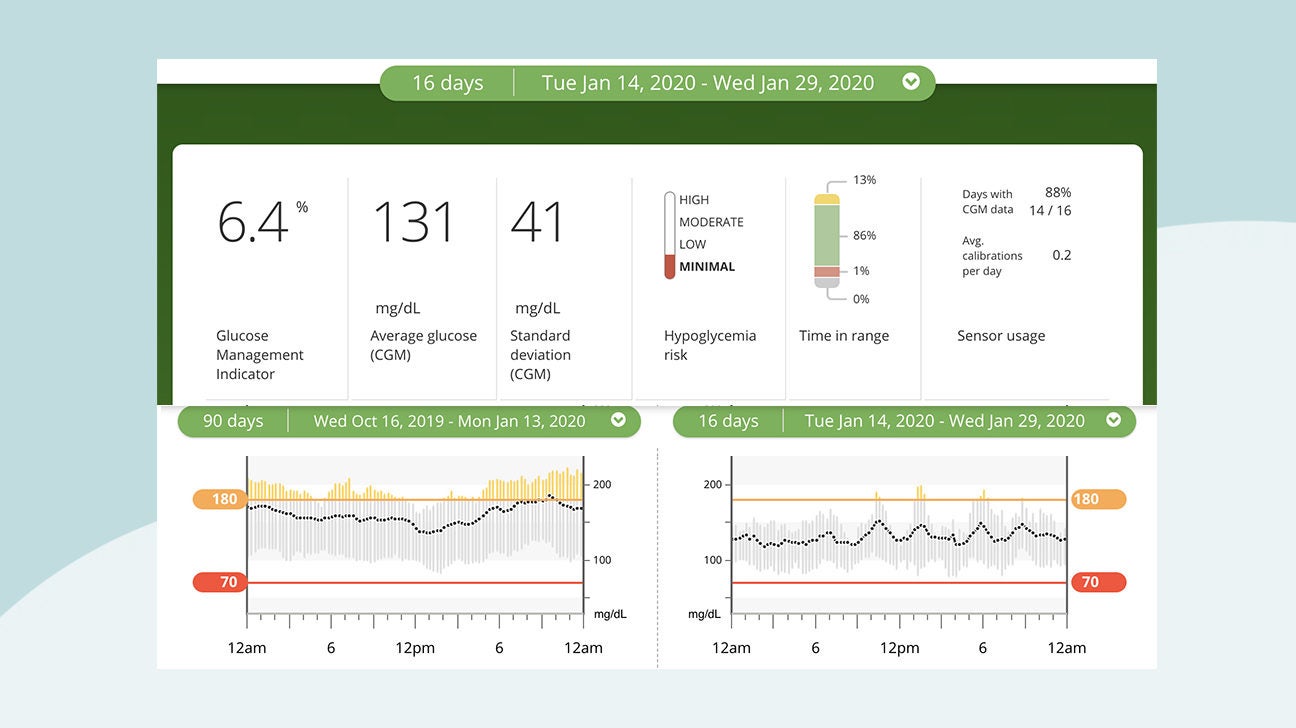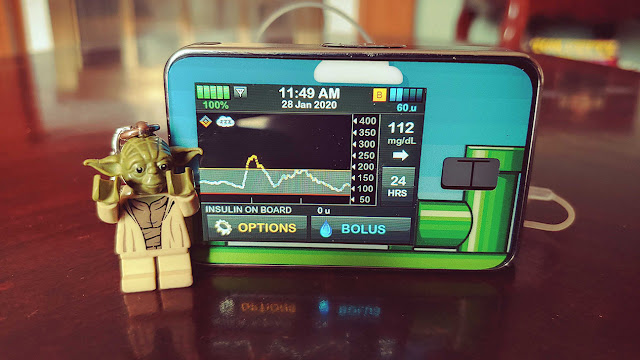Baby Yoda'ing My Diabetes with Tandem's Control IQ Technology
After a couple weeks of using the new Control-IQ feature by Tandem Diabetes Care that helps automate insulin dosing, I am very impressed. Just approved at year's end 2019 and launched in mid-January 2020, this system has earned some high marks from me, along with some suggestions for improvement.
The pop-culture analogy that best describes my experience so far is that Control-IQ is like Baby Yoda — as it's cute and photogenic and has gone viral online. Sure, it has some mystical skills, but it gets tired easily and can't yet fully tap into The Force to keep me at optimal glucose levels all the time.
Quite simply, some days with Control-IQ have been magical for me, while others left me wanting to throw the device to the floor. But there's no arguing with the remarkable Time-in-Range (TIR) results I've achieved over my first two weeks with Control-IQ: between 70 to 180 mg/dL at an impressive 86 percent of the time, up from the roughly 66 percent I saw before.
What is Control-IQ?
Control-IQ is one of a new breed of "closed loop" or Automated Insulin Delivery (AID) systems coming to market that connect a pump, CGM, and control algorithm to create a system that can better mimic what a healthy pancreas does, by monitoring glucose levels and delivering insulin as needed.
The FDA's approval of CIQ in December 2019 was big news for the diabetes community. It is now the most advanced diabetes technology commercially available to date, aimed at reducing the number of low and high blood sugars that one experiences.
Specifically, CIQ combines Tandem's touchscreen t:slim X2 insulin pump with the Dexcom G6 CGM (continuous glucose monitor) via an algorithm that auto-adjusts insulin doses to help keep blood sugars more in range. Its set range is 70–180 mg/dL, but it works hard to keep you as close to 112 as possible, using a variety of methods.
It's not a silver bullet, to be clear, but it's focused on helping you do better and "think less" about the traditional ups and downs that diabetes presents each day.
Users still have to take insulin bolus doses for meals, because the system doesn’t automatically do that. But the auto-correction function can help reduce high blood sugars more quickly if a meal bolus is missed or calculated incorrectly. This is a huge advantage for most of us, whose carb-counting skills are far from perfect, making mealtime insulin doses hit or miss.
As to design, Tandem's colorful "Apple-esque" touchscreen device seems to have gotten even cuter over the years. You can see that I have adorned mine with a Mario-inspired decorative skin. There are dozens of t:slim pump skins to choose from.
Glucose target ranges
Control-IQ is programmed with a variety of target range settings, that differ in part by time of day:
- Regular target range of 112-160 mg/dL, where it maintains your pre-programmed pump basal rates.
- If the CGM predicts you'll rise above 160 mg/dL in the next half-hour, it will increase your basal rates.
- If your glucose is predicted to go above 180 mg/dL in the next half-hour, it will automatically deliver a correction bolus — but only 60 percent of what your pump settings dictate, with a target of 110 mg/dL.
- The optional "Sleep Activity" mode allows a more aggressive range of 110–120 mg/dL. This optional setting does not allow any auto-correction boluses while it's activated, and you can set specific times overnight or just leave it on for the tighter range.
- An optional Exercise mode allows for a target of 140–160 mg/dL.
New mobile app
Going into the Control-IQ launch, Tandem had planned to unveil a new mobile app for this system that would be compatible with both iPhone and Android smartphones. But it's taken longer than expected with beta testing, and the mobile app wasn't ready in time for CIQ launch in early 2020.

Originally, Tandem had planned a gradual roll-out of different app features: first with only auto-uploading of data into Tandem's t:connect platform; then followed by a second-gen feature with data display from both the pump and CGM on the app screen; and eventually control of the t:slim X2 and future pump platform itself directly from the phone app. So yes, you will eventually be able to program bolus doses right from your smartphone.
When t:connect mobile launched on July 7, 2020, Tandem merged the first two features with the new app: auto-uploading as well as data display. You can see the past 24 hours worth of pump and CGM data on the app, including insulin doses and basal rates as well as Dexcom-generated CGM data. For now, the app doesn't allow for supply ordering or remote updating for new features, but Tandem says that's all in the works for future iterations along with the highly-anticipated phone control.
UPDATE: It's exciting that the mobile bolusing feature for the new version of t:connect mobile app is finally FDA-cleared as of 2022, and expects to be available widely by Summer 2022.
Getting started and training
Tandem is rolling this out gradually to new and existing users who have signed up. We were privileged to get early access for product review purposes, and as an existing user of Tandem's t:slim pump, I found the upgrade process quite simple.
Once I received my confirmation email, I logged into the t:connect portal online. This triggered a five-step process confirming my Dexcom G6 use and receipt of my doctor's prescription. With all that confirmed, I was ready to start the training — an interactive program in two parts that took 40 minutes for the first part and 20 for the second. It provides periodical quizzes and prompts much like online traffic school or employee trainings that many of us do online these days.
After completing those modules, I got an authorization code that allowed me to proceed with the actual update to my t:slim X2 — going from Tandem's previous Basal-IQ system that I had been using to the new Control-IQ feature.
The system prompted me to load a new insulin cartridge and start a new CGM sensor session, but I didn't lose the existing G6 sensor I was still wearing. After a brief warmup period (not the full two hours typically required for a new G6 sensor), it started generating CGM data.
Importantly: Once you update from Basal-IQ to Control-IQ, you can't go back to the earlier version. So for anyone who isn't sure about updating just yet, think twice before making the switch.
My results with Control-IQ
As noted, the system has helped me obtain some impressive results that I haven't been able to achieve before starting on this new tech. It's also offering new lessons about how much insulin I'm using overall throughout the day, and helping me pinpoint how my food and drink choices are impacting my glucose levels.
I'm not a statistics-savvy person, but it's still fascinating to see in my first two weeks with Control-IQ that the system has adjusted my basal rates 1,794 times, with 98 percent of those being auto increases or decreases and only 24 percent being insulin suspends. Of my total 102 bolus doses delivered (average six per day), 23 percent were corrections and 11 percent were "extended" doses to cover complex meals. I've used the bolus calculator for 47 percent of my mealtime dosing, and the rest were delivered automatically via Control-IQ.
- Lows are 1–2 percent of my readings, about the same as before.
- Highs are dramatically reduced, down from 33 percent of the time before to now only 13 percent.
- Sleep is improved because the lows are being predicted ahead of time and cushioned (if not fully prevented), while the system automatically corrects to avoid high BGs overnight.

Sometimes I do get rebound highs that the system just can't handle. For example, when I tried out Exercise Mode for the first time while shoveling Michigan snow, but also added a blueberry muffin into the mix. I went high thanks to that muffin and the exercise adrenaline boost, but eventually bottomed out from the delayed snow-shoveling effect. And my rescue carbs ended up being too many girl scout cookies... Grrr. No surprise that I ended up in the 300s with CIQ chugging uphill to catch up. No diabetes tech can yet deal with those monkey wrenches thrown into the mix.
What I like best
By motivating me to follow my own data more closely, Control-IQ is teaching me lessons about exercise routines and sleep patterns. And importantly, it is helping me to start stepping back from over-treating when my glucose levels go low — because under normal circumstances, the basal adjustments and auto-shutoff curtail insulin delivery and help me recover more quickly without stuffing my face.
Some features I find especially helpful are:
Retention of extended boluses. With the prior system, an Extended Bolus got canceled if you went low during the course of that scheduled bolus. Now, Control-IQ allows you to continue delivering the rest of a programmed Extended Bolus if you desire.
Delay of insulin restart. This system also does not immediately resume delivering insulin immediately once CGM data signals that your glucose levels have started to rise after a low. Rather, it takes a moment to assess three of your past four readings (so 15 minutes of data) to make sure you are actually rising before it kicks basal delivery back into action.
Exercise and sleep activity modes. These two optional activity modes are interesting, and I have learned that you can use them in ways other than what the manufacturer intended. For example, I am using the Exercise Mode overnight to shoot for a higher target range of 140–160 to avoid lows. With this, the system will still administer an auto-correction dose if needed overnight. And vice-versa: I have been using Sleep Mode for those times during the day when I'm pretty steady and would rather not have any auto-boluses delivered.
What could be improved
Colors and icons. One of my biggest gripes about Control-IQ so far is the use of very tiny icons, which are tough to see on the pump touchscreen.
- a diamond icon in the top left corner of the screen, signaling that the system is turned on and in use
- a letter "B" in a box at the top right corner, signaling the current basal activity
- Both icons change colors slightly depending on what the system's doing — orange if basal is decreased, different shades of blue and an insulin drop icon if insulin's increased or a bolus is being delivered.
- I am partially color blind, so I have trouble differentiating the varying hues of these icons. I'd like to see these icons larger, and designed more intuitively to reflect a particular status — like maybe a plus or minus symbol next to the B, reflecting a higher/lower basal rate.
Better detail on adjusted basal rates. Likewise, to discover whether the system is increasing or decreasing basal rates, you have to touch that little B basal icon in the top screen to get to a "Current Status" menu that displays the current basal rate being delivered. But it doesn't tell you how much that basal rate differs from your pre-programmed basal rate for that moment. It would be much handier to have the programmed basal rate displayed right above or below the adjusted rate, so you could understand how it's adjusting to your needs.
Slow reactions require patience! The biggest lesson for me is that Control-IQ doesn't react to big changes quickly. That, along with the slower action of the Novolog insulin in the pump compared to the inhalable Afrezza insulin I'd been using previously means I have to remind myself to be patient, and let Control-IQ do its work before over-reacting and manually delivering more insulin.
Dexcom is the weakest link. This hurts to write, because I have long been a fan of Dexcom's CGM over anything else on the market. But unfortunately, the G6 hasn't performed well for me. I get lots of instances when the signal disconnects, making it unreliable.
Also, I have used G6 according to product guidelines but have rarely had one of these 10-day sensors actually last that long. Since mid-October, only three of my sensors have lasted the full 10 days. On average, I get 6 to 7 days per sensor before it malfunctions and stops the sensor session. This means I must repeatedly call in each of those early failures to Tandem/Dexcom to have my sensor replaced.
If others are experiencing these issues with G6 sensors, this could be a major disincentive for patients to turn to Tandem's Control-IQ system.
Answers to key questions on Control-IQ
Here are answers to a few key questions we've heard around the Diabetes Online Community (DOC) about this new technology:
What if you have “tight” diabetes control already?
It is true that as a first-generation automated system, Control-IQ has some limited fixed settings, including the 112 target — whereas if you're aiming for tighter control, you might like to adjust that number downward. I personally am OK coasting between 100 and 150 most of the time, and if I wish to run tighter, it's easy enough to temporarily adjust my basal and correction settings to more aggressively push me lower.
Does Control-IQ have a set 5-hour insulin duration?
Yes, it does. Control-IQ doesn't let you change this. It's a fixed setting of five hours for how long the insulin will remain active in the pump's "Insulin on Board" (IOB) calculations. It's a longer active period than many are used to, but Tandem says they chose this to allow the algorithm to deal with simultaneous calculations for potentially multiple insulin doses. I haven't experienced any negative impacts of this.
How does Control-IQ compare to Medtronic’s Minimed 670G?
Our own Wil Dubois, a longtime type 1 and former clinical educator, has used Medtronic's 670G Hybrid Closed Loop (the only other commercial AID system available) and is currently on Control-IQ. He shares this perspective:
"Both systems did a good job of controlling blood sugar globally, and keeping the pumper in reasonable range most of the time, (but)... Control-IQ is more robust than the Medtronic product. I never had the Tandem pump fall out of auto-mode, except when a new sensor was spooling up," he says.
"All in all, I found Control-IQ to be significantly less of a burden, in terms of life interference... Plus, not only was my overall sugar in better range, most mornings I woke up with an excellent BG around 100 mg/dL, lower than the typical 140s I was seeing on the 670G."
Will I buy it?
Yes, I think so.
Despite my concerns over G6 performance, I do love the technology and how it's helped me boost my Time-in-Range I'm privileged that Tandem supplied me with the pump and necessary supplies during this product review trial period, and now it's up to me to purchase what I need to continue on Control-IQ.
The retail (cash) cost of the Tandem t:slim X2 pump with Control-IQ is $4,000, but Tandem says health insurance typically covers 80 percent of that cost. It's TBD what my insurance coverage looks like for this and whether that factors into my purchasing-decision here, on this expensive durable medical equipment (DME).
It's also reassuring to know Tandem is offering a 100 percent free software update for in-warranty t:slim X2 pump users in the U.S.! So anyone who already owns or buys a t:slim X2 pump in the U.S. before Dec. 31, 2020, will have access to it through the Tandem Device Updater that can be used by just plugging a micro-USB cable into a computer.
Remember, you still need to purchase all the Dexcom G6 CGM supplies separately. While insurance coverage may vary, the retail price would be $237 for a single G6 transmitter that lasts three months and $349 for a box of three 10-day sensors. The Tandem t:slim X2 operates as the “receiver” connecting to the G6, so you don't need to purchase a separate CGM receiver. If you don't go through insurance, you can check out Costco's lower-priced CGM supplies for order at cash price for those who qualify.
UPDATE: Yes, I did end up buying CIQ in early 2021.
The bottom line, for me
This technology is pretty awesome. Sure, it's not perfect because no diabetes tech can make that promise. But seeing improved Time-in-Range has been enough to make me a fan, despite its flaws. And if the Quality of Life improvements have got me feeling more in tune with the "Diabetes Force," then it's a win to me. I'm excited to keep using Control-IQ, and see how it grows up with new features as we move forward.


Comments